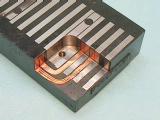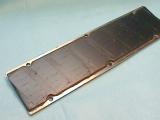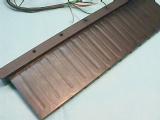
 Search Here
Search Here
MISC
Parts List
Robot Forum
Chat
Member Pages
Axon MCU
Robot Books
Shop
Contact
SKILLS
How To Build
A Robot
Tutorial
Calculators
Mechanics
Programming
Miscellaneous
Robots
Space
HARDWARE
Actuators
Batteries
Electronics
Materials
Microcontrollers
Sensors
SCIENCE
Robot Journals
Robot Theory
Conferences
- Linear motors are like flat X-Y induction motors
- The ends of the motor plane have hard to predict magnetic fields and must be accounted for
- There are many types of linear motors: Voice coil motor, Brushless AC servo motor, Stepping, and variations of these
- Brushless iron-core linear motors must have low cogging force (2% or less)
- 3 phase motors must have low a force ripple
- Ratio of thrust to moving mass determines the load capacity of a linear motor. Less moving mass means more capacity for external load. In addition, the reaction force due to moving mass under high acceleration and deceleration will result in considerable vibration to your machine and may lead to unpredictable resonance. So, a good linear motor stage must keep its moving mass as small as possible.
- Consider if you want to move both axis simultaneous and/or independent
- Duty cycle must be kept low to avoid overheating
- A good linear motor stage must make its number of moving cables as few as possible to increase longevity
- Other factors to consider: Effective stroke, Resolution, External Payload, Moving Mass, Accuracy, Repeatability, Straightness/Flatness, Maximal Velocity, Maximal Acceleration, Coil Inductance
- Dependent on type of linear motor
- Higher voltages generally mean more torque, but also require more power
- Motors can run above or below rated voltage (to meet other design requirements)
- Most efficient at rated voltage
- When buying a motor, consider stall and operating current (max and minimum)
- Stall Current - The current a motor requires when powered but held so that it does not move
- Operating Current - The current draw when a motor experiences zero resistance torque
- It is best to determine current curves relating voltage, current, and required torque for optimization
- When a motor experiences a change in torque (such as motor reversal) expect short lived current spikes
- Current spikes can be up to 2x the stall current, and can fry control circuitry if unprotected
- Use diodes to prevent reverse current to your circuitry
- Check power ratings of your circuitry and use heat sinks if needed
- Running motors close to stall current often, or reversing current often under high torque, can cause motors to melt
- Heat sink motors if not avoidable
- When buying a motor, consider stall and operating torque (max and minimum)
- Stall Torque - The torque a motor requires when powered but held so that it does not rotate
- Operating Torque - The torque a motor can apply when experiencing zero resistance torque
- Changing voltage will change torque
- Motors run most efficient at the highest possible speeds
- Gearing a motor allows the motor to run fast, yet have a slower output speed with much higher torque
- Remember that torque determines acceleration, so a fast robot with poor acceleration is really a slow robot
- If uncertain, favor torque over velocity
- Most efficient at rated voltage
- Motors run most efficient at the highest possible speeds
- Friction is a concern at slower speeds
- Use gearing (opt to buy motors with built-in gearing or gear heads)
- Dependent on motor type
- Most linear motors come with special controllers




note: I have never actually used a linear motor, so feel free to correct and verify this information
note: this page is a place holder until a better tutorial is written
Special notes on linear motors
Voltage
Current
Power (Voltage x Current)
Torque
Velocity
Efficiency
Control Methods
Society of Robots copyright 2005-2014